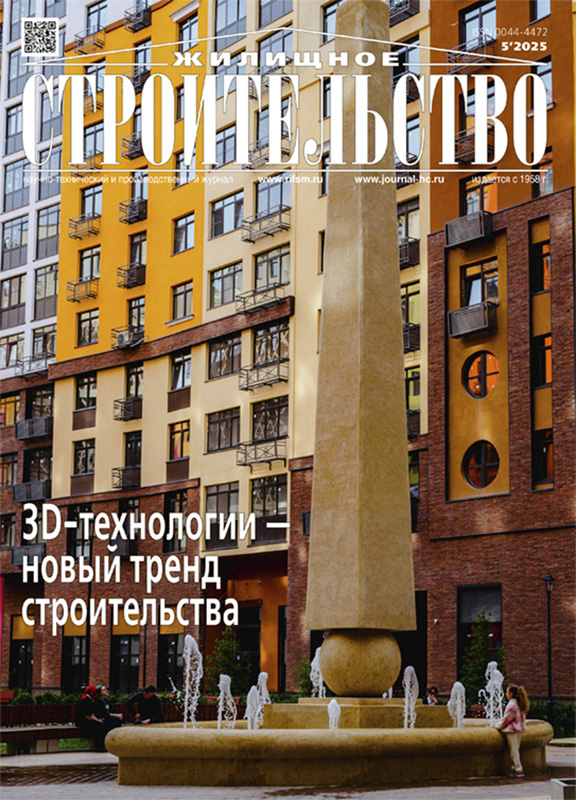Инновации и традиции в возведенных путем 3D строительной печати объектах
- Авторы: Мальцева Е.В.1
-
Учреждения:
- Тюменский индустриальный университет
- Выпуск: № 5 (2025)
- Страницы: 20-27
- Раздел: СТАТЬИ
- URL: https://snv63.ru/0044-4472/article/view/684326
- DOI: https://doi.org/10.31659/0044-4472-2025-5-20-27
- ID: 684326
Цитировать
Аннотация
Современная архитектура обладает крайне разнообразными техническими и эстетическими проявлениями. Определенного стилистического постоянного направления нет, существует разнообразие инструментов архитектуры, способов возведения объектов и современные технические возможности, которые приводят архитектурные формы к опорным и определенным методам их материальности и архитектурной выразительности. Приведен обзор архитектурных решений объектов, возведенных путем 3D строительной печати. Рассмотрены особенности современного архитектурного творчества в контексте высоких технологий, аддитивных, и, в частности, технологий 3D строительной печати. Целью исследования и практических решений концептуальных проектов ИЖС и остановочного комплекса является применение теоретических исследований и заключений об актуальной современной архитектуре в архитектурных проектах. Выбранные архитектурные объекты широко распространены, постоянно реализуются, и для них важны критерии утилитарного комфорта и эстетической привлекательности.
Полный текст
Об авторах
Е. В. Мальцева
Тюменский индустриальный университет
Автор, ответственный за переписку.
Email: maltsevaev@tyuiu.ru
старший преподаватель кафедры архитектуры и градостроительства
Россия, ул. Володарского, 38, Тюмень, 625000Список литературы
- Холодова Л.П. О современных архитектурных процессах // Архитектон: известия вузов. 2023. № 3 (83). EDN: VMYLPS. https://doi.org/10.47055/19904126_2023_3(83)_10
- Heijden J. Construction 4.0 in a narrow and broad sense: A systematic and comprehensive literature review. Building and Environment. 2023. Vol. 244, 110788. EDN: VDMUVB. https://doi.org/10.1016/j.buildenv.2023.110788
- Славчева Г.С. Строительная 3D-печать сегодня: потенциал, проблемы и перспективы практической реализации // Строительные материалы. 2021. № 5. С. 28–36. EDN: WACJMY. https://doi.org/10.31659/0585-430X-2021-791-5-28-36
- Адамцевич Л.А., Гинзбург Е.А., Шилов Л.А. Строительство 4.0 // Жилищное строительство. 2023. № 11. С. 18–23. EDN: WZTILE. https://doi.org/10.31659/0044-4472-2023-11-18-23
- Barry Berman. 3-D printing: The new industrial revolution. Business Horizons. 2012. Vol. 55, Iss. 2, рр. 155–162. https://doi.org/10.1016/j.bushor.2011.11.003
- Разов И.О., Соколов В.Г., Дмитриев А.В., Еренчинов С.А. Предложение по устройству перекрытия при возведении зданий с помощью аддитивных технологий // Строительные материалы. 2023. № 10. С. 116–120. EDN: LMBOKS. https://doi.org/10.31659/0585-430X-2023-818-10-116-120
- Рахимов Р.З., Мухаметрахимов Р.Х., Зиганшина Л.В. Совершенствование аддитивных технологий малоэтажного жилищного строительства // Жилищное строительство. 2024. № 8. С. 11–19. EDN: IUNORV. https://doi.org/10.31659/0044-4472-2024-8-11-19
- Wang X., Li W., Guo Y., Kashani A., Wang K., Ferrara L., Agudelo I. Concrete 3D printing technology for sustainable construction: A review on raw material, concrete type and performance. Developments in the Built Environment. 2024. Vol. 17. EDN: BYYQXK. https://doi.org/10.1016/j.dibe.2024.100378
- Адамцевич А.О., Пустовгар А.П., Адамцевич Л.А. Аддитивное строительное производство: обзор мирового опыта // Промышленное и гражданское строительство. 2023. № 12. С. 83–97. EDN: GVFBHM. https://doi.org/10.33622/0869-7019.2023.12.83-97
- Пермяков М.Б., Краснова Т.В., Дорофеев А.В. Аддитивные технологии в строительстве и дизайне архитектурной среды: настоящее и будущее // Актуальные проблемы современной науки, техники и образования. 2018. Т. 9. № 2. С. 2–5. EDN: XZNWEX
Дополнительные файлы




















